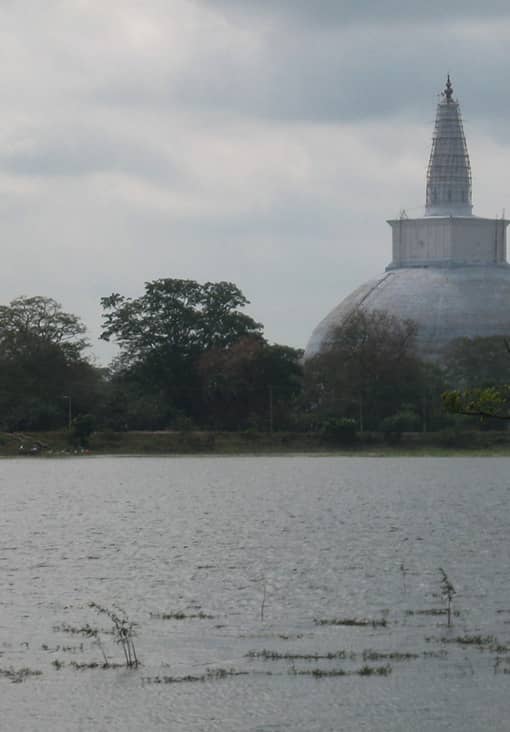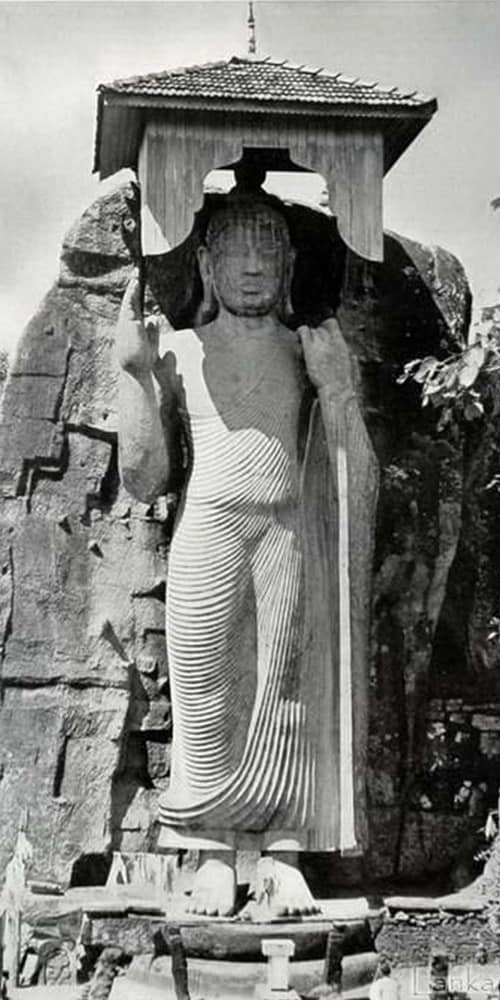
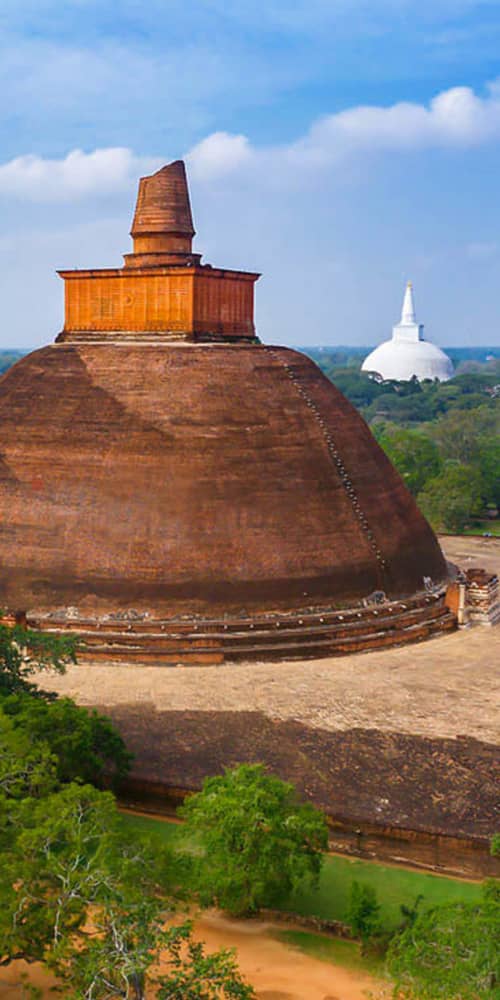
Wonders to Experience
Our attractions and packages are centered around some of the most historically, culturally, and archaeologically significant places in Sri Lanka.
Starting from the UNESCO World Heritage Listed ancient capital of Anuradhapura, spanning towards the beautiful sandy coastlines of Jaffna and Trincomalee. The city of Anuradhapura was founded ca. 350 BC by king Pandukabhaya.
Our hotel is situated amidst the wonders of the peerless ancient city of Anuradhapura, making it very easy for our guests to traverse freely through the ancient capital.
Anuradhapura is considered as one of the most important cities in Sri Lanka due to its rich history and the archaeological and cultural monuments that are clustered throughout the city.
The Eight Sacred Places in Anuradhapura City
The following places of worship are considered the main Buddhist monuments that still are intact even after the onslaught of serial South Indian invations and exposure to elements throughout some 2000 years.
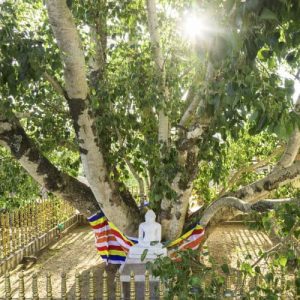 Situated in the precincts of the World Heritage List ancient city of Anuradhapura, this sacred tree has a well-recorded history since 236 BC when it was planted here. A sapling from the original bo tree of India’s Bodhgaya (aka Buddha Gaya) under which the Indian Prince Gauthama attained enlightenment was sent as a cultural gift to the island’s King Devanampiyatissa by India’s Emperor Ashoka. Emperor’s daughter, Sanghamithra herself ceremonially brought this from Buddha Gaya to Anuradhapura. This is a site much venerated by Buddhists from around the world. In a botanical context this is a superb specimen of Ficus religiosa which is native to tropical Asia and treated as sacred in Indian sub-continent and has a very long lifespan. In the Buddhist tenets mention is made to Buddha reciprocating by paying respect and gratitude to the parent tree at Bodh Gaya which tree gave him shade and shelter in the process of his superhuman feat of achieving enlightenment or Nirvanic comprehension, i.e. for seven days he unblinkingly beheld the tree. People prostrate and venerate before this tree and the act gives the world a somewhat paradoxical message to protect trees.
Situated in the precincts of the World Heritage List ancient city of Anuradhapura, this sacred tree has a well-recorded history since 236 BC when it was planted here. A sapling from the original bo tree of India’s Bodhgaya (aka Buddha Gaya) under which the Indian Prince Gauthama attained enlightenment was sent as a cultural gift to the island’s King Devanampiyatissa by India’s Emperor Ashoka. Emperor’s daughter, Sanghamithra herself ceremonially brought this from Buddha Gaya to Anuradhapura. This is a site much venerated by Buddhists from around the world. In a botanical context this is a superb specimen of Ficus religiosa which is native to tropical Asia and treated as sacred in Indian sub-continent and has a very long lifespan. In the Buddhist tenets mention is made to Buddha reciprocating by paying respect and gratitude to the parent tree at Bodh Gaya which tree gave him shade and shelter in the process of his superhuman feat of achieving enlightenment or Nirvanic comprehension, i.e. for seven days he unblinkingly beheld the tree. People prostrate and venerate before this tree and the act gives the world a somewhat paradoxical message to protect trees.![]()
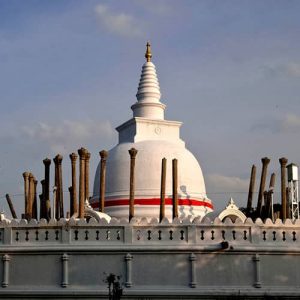 Upon establishing Buddhism as state religion in the island by India’s Emperor Asoka ca. 250 BC, King Devanampiya Tissa who ruled the island till 210 BC built this stupa and its Jethavana Monastery compound of some 1.2 ha which is in ruins now. This is the premier stupa built in the island. Historical chronicles mention that the Buddha’s right collarbone has been enshrined in the stupa. There is an ancient inscription at Thuparama compound that decreed a considerable extent of rice paddies nearby allocated for the sustenance of the incumbent monks of the past times. In the 1840s the British government in Ceylon fully restored the stupa to its present state.
Upon establishing Buddhism as state religion in the island by India’s Emperor Asoka ca. 250 BC, King Devanampiya Tissa who ruled the island till 210 BC built this stupa and its Jethavana Monastery compound of some 1.2 ha which is in ruins now. This is the premier stupa built in the island. Historical chronicles mention that the Buddha’s right collarbone has been enshrined in the stupa. There is an ancient inscription at Thuparama compound that decreed a considerable extent of rice paddies nearby allocated for the sustenance of the incumbent monks of the past times. In the 1840s the British government in Ceylon fully restored the stupa to its present state.
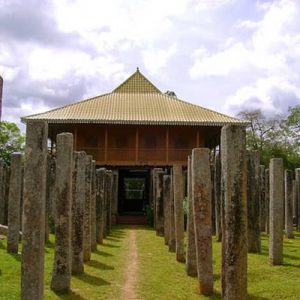 Located between Ruwanwelisaya and Jaya Sri Maha Bodhi in the city of Anuradhapura, this is also known as the Brazen Palace or Lohaprasadaya because the roof was covered with bronze tiles. It was originally built by King Dutugemunu more than 2000 years ago, but throughout the ages it was rebuilt many times, each time a little less grandiosely. There are remains of 1600 columns all that is left of this huge palace, archaeological evidence said to have had nine storeys and could accommodate around 1000 monks.
Located between Ruwanwelisaya and Jaya Sri Maha Bodhi in the city of Anuradhapura, this is also known as the Brazen Palace or Lohaprasadaya because the roof was covered with bronze tiles. It was originally built by King Dutugemunu more than 2000 years ago, but throughout the ages it was rebuilt many times, each time a little less grandiosely. There are remains of 1600 columns all that is left of this huge palace, archaeological evidence said to have had nine storeys and could accommodate around 1000 monks.
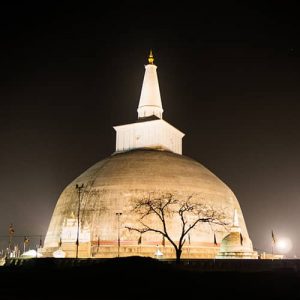 The Ruwanwelisaya is a stupa in Sri Lanka, considered a marvel for its architectural qualities and sacred to many Buddhists all over the world. It was built by King Dutugemunu, who became lord of all Sri Lanka after a war in which the South Indian Chola King Elara (aka Ellalan,) was defeated. It is also known as Mahathupa, Swarnamali Chaitya, Suvarnamali Mahaceti (in Pali) and Rathnamali Dagaba. King Dutugemunu didn’t live to see its completion of dageba but his final sight as he lay on his deathbed could be a false bamboo- and-cloth finish was placed around the dageba to show his ‘completed’ masterpiece. Today, after incurring much damage from invading Indian forces, it rises 55m, considerably less than its original height; nor is its form the same as the earlier ‘bubble’ shape. A limestone statue south of the great dageba is popularly thought to be of King Dutugemunu.
The Ruwanwelisaya is a stupa in Sri Lanka, considered a marvel for its architectural qualities and sacred to many Buddhists all over the world. It was built by King Dutugemunu, who became lord of all Sri Lanka after a war in which the South Indian Chola King Elara (aka Ellalan,) was defeated. It is also known as Mahathupa, Swarnamali Chaitya, Suvarnamali Mahaceti (in Pali) and Rathnamali Dagaba. King Dutugemunu didn’t live to see its completion of dageba but his final sight as he lay on his deathbed could be a false bamboo- and-cloth finish was placed around the dageba to show his ‘completed’ masterpiece. Today, after incurring much damage from invading Indian forces, it rises 55m, considerably less than its original height; nor is its form the same as the earlier ‘bubble’ shape. A limestone statue south of the great dageba is popularly thought to be of King Dutugemunu.
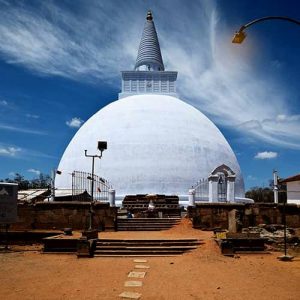 King Dutugamunu (161 BC to 137 BC) creator of Ruwanweliseya also built the Mirisawetiya after defeating South Indian invader king Elara. This stupa is some 66 m high and centred in a 20 ha monastery which is in ruins today. According to the legends, it had been a practice of the King Dutugemununu to offer foods to Buddhist monks before he consumes them. However, one day he forgot to offer a food made of chilly. As an apology for this, the king has named this stupa as Mirisawetiya (the
King Dutugamunu (161 BC to 137 BC) creator of Ruwanweliseya also built the Mirisawetiya after defeating South Indian invader king Elara. This stupa is some 66 m high and centred in a 20 ha monastery which is in ruins today. According to the legends, it had been a practice of the King Dutugemununu to offer foods to Buddhist monks before he consumes them. However, one day he forgot to offer a food made of chilly. As an apology for this, the king has named this stupa as Mirisawetiya (the
Sinhala word “Miris” has the meaning of chilly). The stupa has been renovated later by a number of kings.
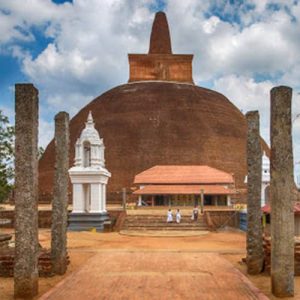 Somewhere between 89 BC and 77 BC King Wattagamani Abhaya (aka Valagamba) built this stupa centred in a monastic complex of some 230 ha which now is in ruins.
Somewhere between 89 BC and 77 BC King Wattagamani Abhaya (aka Valagamba) built this stupa centred in a monastic complex of some 230 ha which now is in ruins.
Abhayagiri monastery was one of the most extensive site of ruins in the world in the denominations of Angkor Wat (Cambodia) and Borobudur (Indonesia.) The 5th century traveller monk Fa-Hsien from China described the stupa as 400 feet (122 meters) high and decorated with gold and silver and studded with all kinds of jewels. There also has been a 20 foot (6.1 meters) high Buddha statue made out of green jade. Being the second largest stupa in the island Abhayagiriya deserves a visit by the concerned traveller.
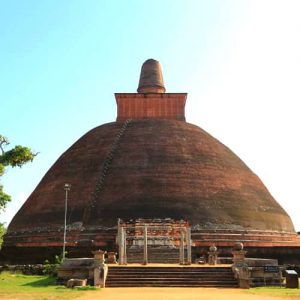 King Mahasen (273 – 301 BC) built this colossus of a Buddhist temple of worship to be the tallest stupa among contemporary counterparts elsewhere in the world, towering at 122m within the World Heritage city of Anuradhapura. Extensive compound of Jethavana Monastery, now in ruins scattered in some 6.5 ha, surrounds the edificial structure of the stupa. Though its height is less now it still has the largest base of its kind, some 200,000 m2 . Besides being a peerless stupa this structure is an archaeological marvel in a civil engineering sense as well.
King Mahasen (273 – 301 BC) built this colossus of a Buddhist temple of worship to be the tallest stupa among contemporary counterparts elsewhere in the world, towering at 122m within the World Heritage city of Anuradhapura. Extensive compound of Jethavana Monastery, now in ruins scattered in some 6.5 ha, surrounds the edificial structure of the stupa. Though its height is less now it still has the largest base of its kind, some 200,000 m2 . Besides being a peerless stupa this structure is an archaeological marvel in a civil engineering sense as well.
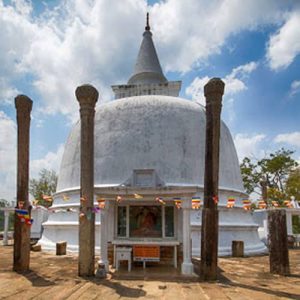 The Lankaramaya stupa was built on the 1st century BC by King Vattagamini Abaya (aka Walagamba). The ancient name of this temple is “Silasobbha Khandaka Cetiya”
The Lankaramaya stupa was built on the 1st century BC by King Vattagamini Abaya (aka Walagamba). The ancient name of this temple is “Silasobbha Khandaka Cetiya”
After the defeat by the Tamil invaders on the same year he came to the throne king Walagamba (103 BC) has hidden in a place called “Silasobbha Khandaka” and after defeating the South Indian invaders and regaining the throne he has built this stupa by the same name. This stupa is similar to Thuparama which is the first stupa built after Buddhism was brought to the country in the 250 BC. This stupa too has had a magnificent vatadage surrounding the stupa. There are indications of 88 stone pillars have supported the roof of the Watadage. Today only few remains out of these.
OTHER ATTRACTIONS IN AND AROUND ANURADHAPURA
Isurumuniya
Isurumuniya is part and parcel of Anuradhapura World Heritage city. The temple here was built by King Devanampiya Tissa who reigned from 307 BC to 267 BC. The site has a recorded history of more than 2,500 years and is the birth place of King Ravana of epic Indian work Ramayana or Mahabharatha. Ranmasu Uyana is an ancient royal water garden of some 16 ha, attached to the Thuparama complex. It has many ponds and other ancient structures in ruins. When the nearby irrigation tank Thissa Wewa was built in 3rd century BC by King Devanapiya Tissa this garden was also built. Sakwala Chakraya of cosmic circle is a carving in the Isurumuni gardens which is an ancient world map according to archaeologists. A significant ancient monument at Isurumuniya is the Isurumuniya Lovers. Legend has it that Crown Prince Saliya, son of King Dutugemunu met in this garden the stunning beauty, the commoner or rather the lowest-caste maiden Asokamala for whom the prince gave up the throne for a left- anded marriage or a morganatic matrimony, and the statue depicts Saliya who had relinquished royal titles, and, Asokamala.
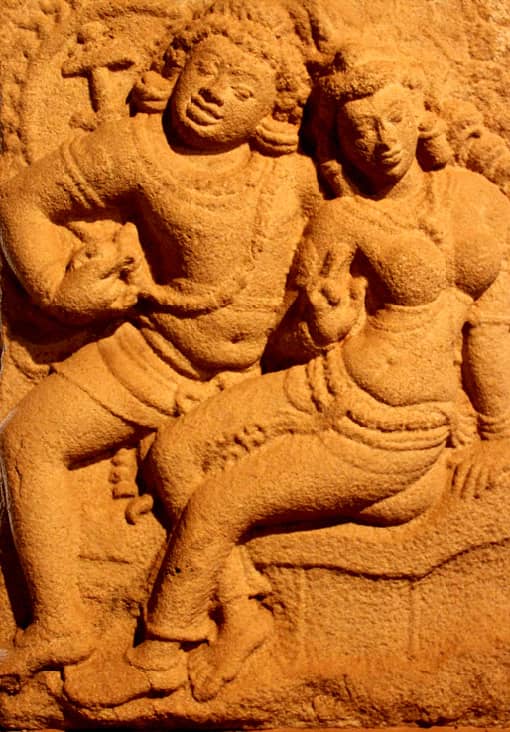
Sanda Hiru Seya
Sanda Hiru Seya which is a modern Buddhist Stupa in Anuradhapura the construction of which was commissioned in 2010 in the continuing Sri Lanka tradition of paying more attention to building Buddhist monuments, is an index of prosperity during peace time.
Two thousand years after the first of the great dagobas were built, commissioned by President Mahinda Rajapaksa in 2010. Designed to reach 85m in height, with a circumference of 244m, it will eventually rise above the ancient dagobas of Jetavanarama and Abhayagiri (but will not surpass their original heights). Sandahiru Seya is being constructed from over 30 million bricks and will be plastered and then whitewashed when finished.
Controversially, this is just one of nine new stupas planned, on orders of the president “In appreciation of the valiant services rendered by the armed forces and police to defeat 30 years of separatist terrorism and bring lasting peace to the country.” However, some have objected to the principle of dedicating a Buddhist monument to the actions of the Sri Lankan military.
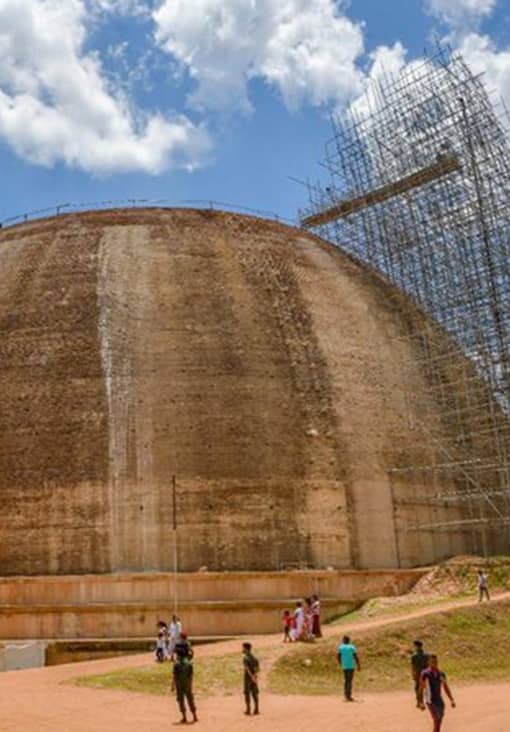
Gal Palama or Stone Bridge
Only the part of the bridge that had been built over the river Malwathu Oya can be seen today. Stone slabs are laid across rows of 3 stone pillars. There have been attempt to restore this bridge in the recent past but work has been abruptly stopped. These stone bridges are thought to be belonging to the late Anuradhapura period. Besides, ruins of various bridges around Anuradhapura can be found across Malwathu Oya, Hal Pan Ela, Kandara Oya, Yan Oya, Kala Oya and Deduru Oya. This stone bridge has been dated to 5-9th centuries BC.
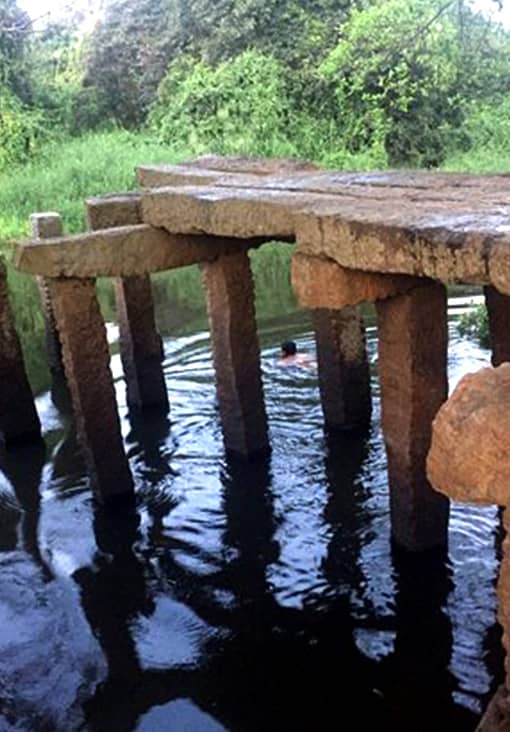
Mihintale
Some 12 km east of Anuradhapura a cluster of hills clad in monsoonal greenery forms the Mihintale complex where several stupas, monastic caves, ruinous ancient hospital, ponds exist. The most of these archaeological, cultural, and religious assets date back beyond 2000 years. The Mihintale summit rises some 300m from the Mihintake plains. The ancient stairway to the summit of Mihintale mountain has some 1800 rock-cut steps and steps made of cut granite.
In the month of June great numbers of pilgrims visit Mihintale in commemoration of the visit to Mihintale by the Indian Buddhist mission headed by Ven. Mahinda whose father Emperor Ashok was instrumental in disseminating the Indian Buddhism in the island where the population was worshipping demons and gods. There is no gainsaying that the Emperor Ashoka’s magnanimous act helped the islanders is in the course of several generations to become so prosperous and pious that many an edifice big or small, in the vast ancient city of Anuradhapura is distinctly telltale.
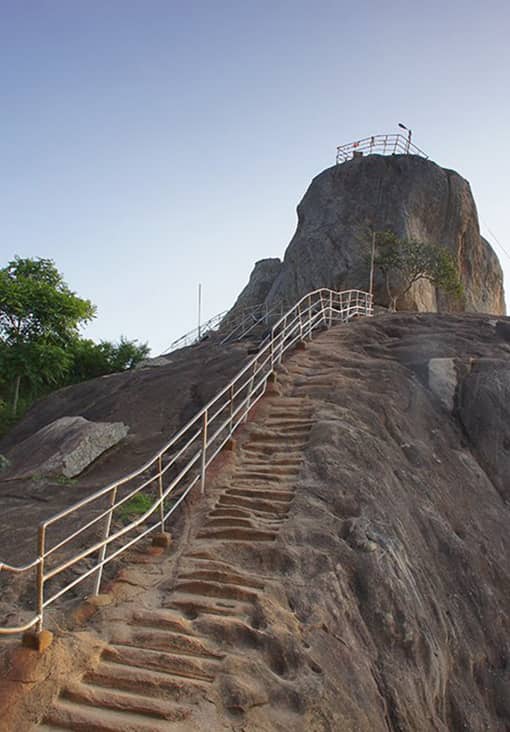
Thanthrimale
Thanthrimale ancient Buddhist site is some 40 km NW of Anuradhapura. The temple was built in the 3rd century BC by king Devanampiya Tissa on a rocky outcrop. On the Thanthrimale rock there are ponds and various ruins of an ancient monastery. Thanthrimale caves contain ancient paintings and inscriptions. A stupa, a sacred bo tree, and several statues are in the rocky area. There is also an archaeological museum.
Views from the rock of the surrounding monsoonal plain are breathtaking. A daytime visit entails sightseeing for the above-mentioned ancient things and the scenic panorama, a nightly visit on a full moon poya day will provide the visitor with much serenity with illuminated stupa.
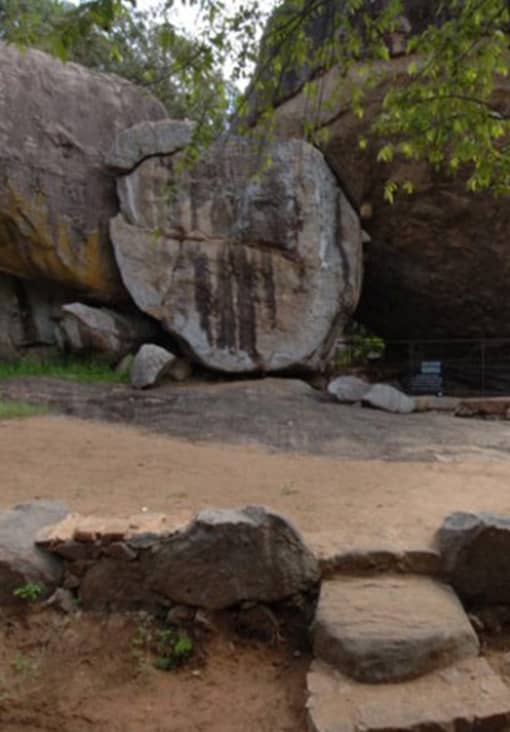
Res Vehera
Reswehera or Sasseruwa is an ancient temple which was built by the King Devanampiya Tissa (307BC-267BC) situated 50 km south of Anuradhapura.
The temple is well known for its two Gautama Buddha statues, one carved in a rock and the other inside the vihara. In addition, the Bo tree which was planted from a branch of the sacred Jaya Sri Maha Bodhi add luminance to the historical value of the place.
The colossal statue of Buddha towers above at some 40 feet. According to chronicles, King Mahasen (276-303 AD) who ruled from Anuradhapura built a statue called “Rahera” statue at the base of the “Rahera” cliff. The reclining Buddha statue inside the temple measures some 40 feet. Res Vehera is scenic with its ancient lake and the rocky outcrops. There are several caves as well and signs of incompleteness in the standing statue that depicts Buddha’s compassionate gesture of no-fear.
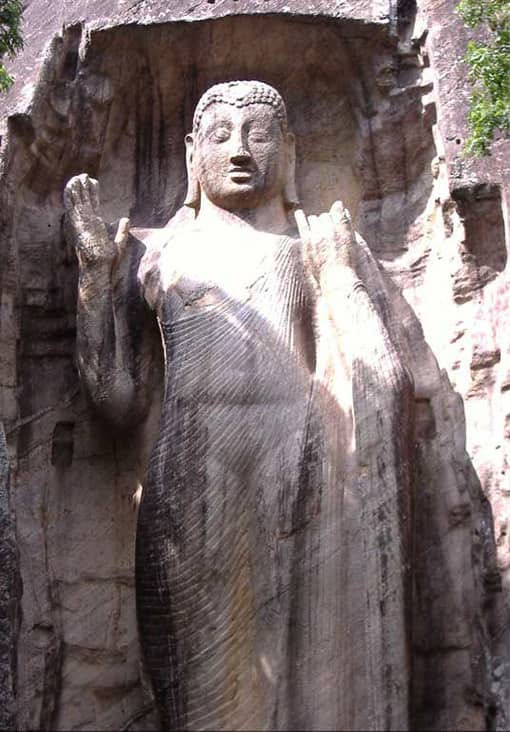
Ritigala
Ritigala 43 km south of the World Heritage city of Anuradhapura is a massif of with the highest peak at some 750 m from MSL and rising 600m above the surrounding monsoonal plains. Ritigala hills are situated within a Strict Natural Reserve of some 1500 ha. Amid the hills there is a micro-climate cooler than the rest of the island’s dry zone.
The ancient monastery at Ritigala dates back to 1st century BC. There are inscriptions, well-preserved granite stairways, ponds, wildlife, and breathtaking verdant scenery. Higher elevations of Ritigala is misty and shrouded in clouds in the SW monsoon season.
At the end of the tenth century, Ritigala came under the barrage of South Indian invasions. By the 10th-12th century AD Ritigala seems to had been abandoned by the hermit monks and soon it retreated into the jungles and rediscovered in the late 19th century by James Mantell, a government surveyor. A couple of decades later, the first Archeological Commissioner in Ceylon H.C.P. Bell visited Ritigala and published a report on his archeological investigations.
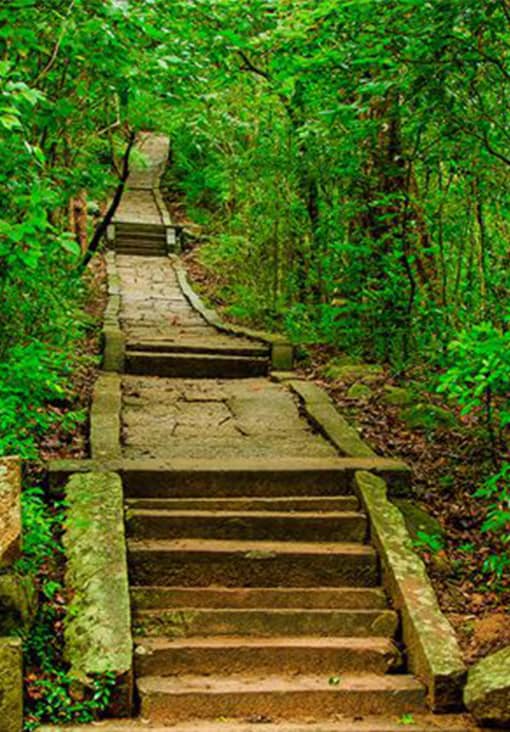
Kalawewa
About 460 AD, King Dhatusena built Kalawewa irrigation reservoir. Actually Kalawewa is a combined reservoir, the smaller reservoir being Balaluwewa. Together the capacity is some 120 million metre 3 of water. Kalawewa tank’s spillway is made of granite. From the main sluice, Yodha Ela or Giant Canal carries water irrigating several thousands of hectares of rice paddies and finally discharging water into the Thissa Wewa reservoir in the ancient city of Anuradhapura or the City of Irrigation. The restoration of Kalawewa had been one of the very ambitious tasks of many English Governors during the British rule of Ceylon and after many trials the canal was renovated in 1880. Another 18 reservoirs were also restored by the British parallel to Yodha Ela system.
The Yodha Ela canal runs 87 km with a gradient approximately 100 mm per 1.0 km (6 in per 1 mile) or in other words runs almost parallel to topographical contours. Even with the modern day survey equipment find it hard to achieve this level of accuracy, and it was a marvelous feat of hydraulic engineering of ancient Ceylon. Yodha Ela irrigates some 4600 ha of rice fields in a territory of about 470 km 2 and fills some 120 of minor tanks along its conduit.
Kalawewa reservoir is a picturesque location besides being a place to watch herds of wild elephants, including majestic tuskers. Moreover, there is a freshwater fishing industry connected with the reservoir.
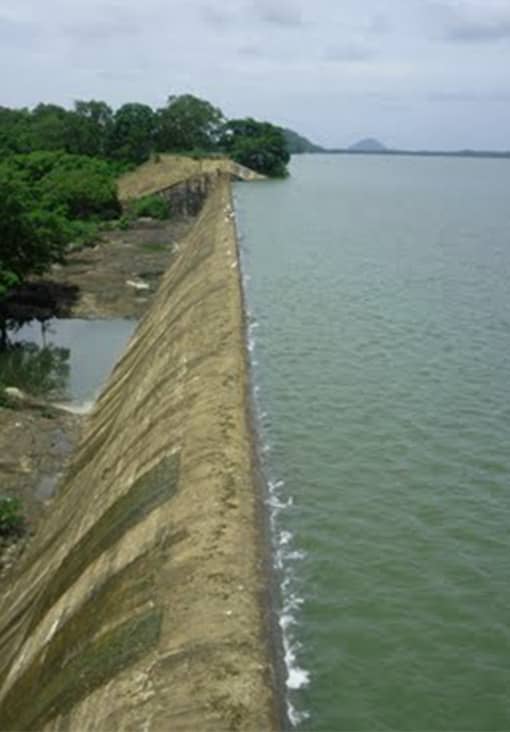
Avukana Buddha Statue
Some 50 km south of Anuradhapura, at Avukana there exists the ancient colossal standing statue of the Buddha, carved out of granite rock outcrop, a timeless masterpiece. The statue is 12m high and gives a timeless gesture of Abhaya Mudra or the compassionate “fearlessness” or “no fear” signal to the beholder. The statue was made circa 500 AD in the reign of King Dhatusena.
The Avukana statue shows some influence of the Gandhara school of art, as well as the Amaravati school of art of India. The robe is worn tightly, clearly outlining the shape of the body, and its pleats are carved clearly and delicately. It is worn over the left shoulder, and the right shoulder is bare, as is the tradition in Buddha statues of Sri Lanka. The Buddha’s body is straight, and the left hand clutches the robe at the left shoulder. The right hand is raised up to the right shoulder, with the palm facing left.”
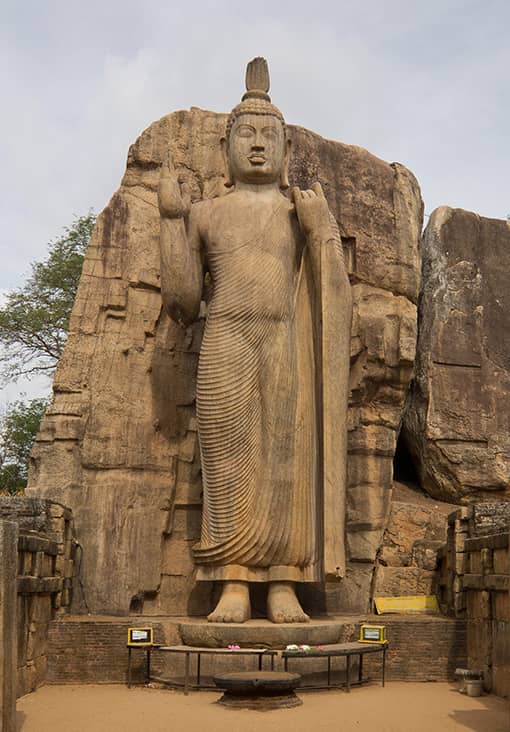
Nuwara Kalawiya or The City of Irrigation
Anuradhapura hydraulic civilization has been the most prosperous, peaceful, pious, and serenely happiest era of the island and all available telltale signs and historical facts indicate. In the irrigation engineering parlance Anuradhapura is the City of Irrigation in the macro-axis of the Anuradhapura District’s three largest man-made tanks, i.e. Nuwarawewa, Kalawewa, and Padaviya which irrigational axis is commonly called by the acronym “Nuwarakakaviya” formed byamalgamating the initial syllables of the names of the first two of above-mentioned three major tanks and the last syllable of the third.
There are two other major tanks namely Mahawilachchiya Reservoir and Mahakanadarawa Reservoir which are somewhat smaller than the trio NuwaraKalaViya. These five are called Panchamahajalasha of Five Great Lakes like those five inland seas in North America.
Besides these five there are some 1000 of minor tanks and village-level tanks in the Anuradhapura District alone and google Maps and Earth show these countless tanks pockmarking the Nuwarakalaviya realm.
There is no gainsaying that the ancient Ceylon was the wonder of irrigation in the contemporary world. Still wonderful is that some 20 centuries later these reservoirs keep fully serving and sustaining the present population today.
Seeing these human-made great lakes is believing in a great civilization lost some 800 years ago believably owing to South Indian invasions and plunders that ensued, no less atrocious than Moghul Invasion of India and destruction of Nalanda University etc. that followed.’
